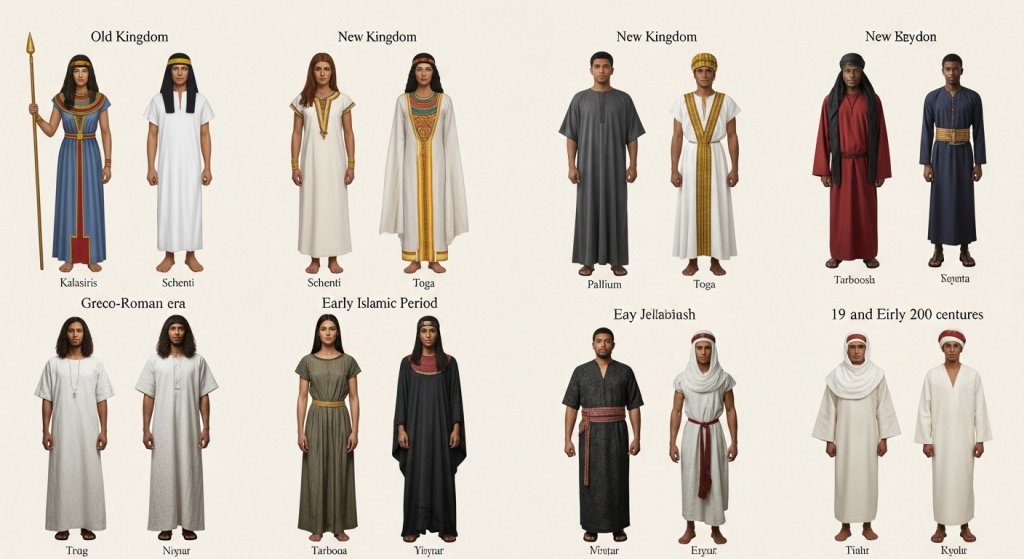Are you interested in learning more about traditional Egyptian clothing? Egypt is a country rich in history and culture, and fashion plays a big role in expressing Egyptian identity. In this article, we will explore the different types of clothing that Egyptians wear, from traditional to modern Egyptian clothing.
We will cover everything from ancient Egyptian cultural dress to what people wear today in cities and the countryside. Whether you are planning to visit Egypt or you just want to understand the culture better, this guide will provide you with everything you need.
History of Egyptian Fashion
To understand traditional Egyptian clothing, we must go back in time.
- Pre-Ptolemaic: In ancient Egypt, clothing was simple and practical. Men wore kilts made of linen, and women wore long dresses. Clothing reflected social class; the upper classes wore finer and more ornate clothes.

- Post-Ptolemaic and Late Antiquity: After Alexander the Great’s conquest, Egyptian fashion was influenced by Greek and Roman culture. Clothing became more complex with more layers and colors.
- Medieval: During the Islamic era, modesty became an important part of clothing. Clothes became wider and more covering, and robes and galabiyas became common.
- Modern: In the modern era, Egyptians began to combine traditional and modern Western fashion. Today in Greater Cairo, you will find a mix of traditional clothes like the galabiya with modern Egyptian clothing like jeans and shirts.
Regional and Ethnic Clothing in Egypt
Traditional clothing in Egypt differs from one region to another, reflecting the cultural diversity of the country.
- The Delta: In northern Egypt, men wear white cotton galabiyas, while women wear simple and modest dresses.
- Middle Egypt: The fashion here is similar to that of the Delta but with some slight differences in colors and designs.
- Upper Egypt: In Upper Egypt, people adhere more to traditions. Men wear Upper Egyptian galabiyas known for their wide and loose sleeves.
- Oases:
- Kharga and Dakhla: The clothing of the oases is influenced by the desert environment.
- Farafra and Bahariya: Clothing is characterized by light colors and loose-fitting garments to protect from the sun.
- Siwa: Siwan fashion is known for its intricate and colorful embroideries.
- Traditional Egyptian Nubian Clothing: In southern Egypt, near Sudan, Nubians wear colorful and decorated clothes. The fashion of Nubian women is characterized by wide dresses and large jewelry.
Types of Traditional Clothing
In Egypt, there are different types of clothing worn by men and women.
Clothing for Both Men and Women
- The Galabiya: It is the most common loose-fitting garment in Egypt. It is worn by both men and women and comes in different colors and designs.
Women’s Wear
- The Abaya: A long and wide dress, often black, worn over other clothes.
- Conservative dresses: Many women in Egypt, especially in rural areas, prefer to wear clothes that cover the entire body.
Men’s Wear
- The Kaftan: It is similar to the galabiya, but it is more formal and may be embroidered.
- The Abaya: Men sometimes wear it on formal occasions.
Accessories, Jewelry, and Footwear
Traditional fashion is not complete without accessories.
- Jewelry: Jewelry is an important part of the traditional Egyptian costume, especially silver and gold.
- Cosmetics: Ancient Egyptians have been using kohl for thousands of years, and its use is still common today.
- Footwear: Traditional footwear is simple and practical, such as leather sandals.
Importance of Fashion in Egypt
The phrase “fashion is an expression of identity” holds deep meaning in Egypt. More than just clothing, what people wear is a living reflection of the country’s diverse landscape, rich history, and deeply held beliefs.
A Tapestry of History and Identity
Egyptian clothing is a blend of influences that have shaped the nation for thousands of years. From the simple linen garments of the Pharaohs to the flowing fabrics introduced during the Islamic era, each historical period has left its mark. Traditional Egyptian clothing, like the galabiya, is not just a comfortable garment; it’s a link to the past, a symbol of heritage passed down through generations. This is why you’ll see it worn proudly in both rural villages and bustling city centers.
Adapting to Modernity
Today, modern Egyptian clothing is a fascinating mix of old and new. Young Egyptians, especially in major cities like Cairo and Alexandria, have embraced global fashion trends. Yet, they often combine these with traditional elements, creating a unique style that is distinctly Egyptian. This blend of modern Egyptian clothing female and male styles shows a culture that is confident in its identity and capable of adapting without losing its core values. It proves that tradition and modernity can coexist, with fashion being the bridge between them.
What to Wear When you Visit Egypt
When you visit Egypt, it is important to respect the local culture.
- Everyday wear: In major cities like Cairo, you can wear light and comfortable clothes. However, it is preferable for clothes to be modest, especially when visiting religious places.
- Conservative dresses: It is preferable to wear clothes that cover the shoulders and knees, especially for women, and this applies particularly to visiting mosques and churches.
Conclusion
Traditional Egyptian clothing is a wonderful blend of history, cultural diversity, and beauty. It is an integral part of the Egyptian identity. We hope that this article has given you a better understanding of these wonderful clothes. If you want to learn more about the Arabic language and culture, why not download the Kaleela Arabic learning app today?



